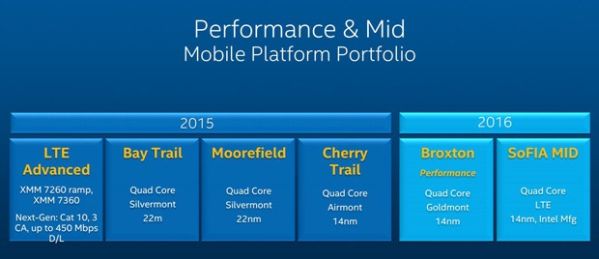Bay Trail was quite a big deal when it started shipping in late 2013.
It was a tablet chip that enabled great design wins such as the affordable Asus T100TA and even in late 2014 Asus used the platform to create the EeeBook X205, a $199 netbook.
Both of these designs are based on Intel's Bay-Trail M processor, a year old 22nm quad-core processor based on the Silvermont design. Some machines that are coming with LTE, both netbooks and tablets and there will be new chip coming in 2015. It is called LTE Advanced XMM7360 chip and supports LTE Cat 10,3 CA up to 450 Mbits download and upload.
Intel will also offer Morrefield quad cores for machines with lower TDP ratings, especially tablets, and at some point in 2015 it will introduce its 14nm Airmont core based Cherry Trail processor. Cherry Trail based on 14nm Airmont core was originally expected in late 2014, but it got pushed towards middle of 2015.

Intel is clearly encountering more obstacles moving from the 22nm to the 14nm manufacturing process, but considering that most ARM competitors still have to start commercially shipping its 20nm SoCs in significant volumes, Intel still has a manufacturing node advantage. If only Intel had as many design wins to go along with its cutting edge fabs, as the company has been struggling to ship 40milion tablets in 2014, as promised.
Braxton will replace Cherry Trail in 2016. Braxton is a tock architecture, another 14nm design based on the quad-core Goldmont core. When it comes to the Performance Media Internet Device (MID) market Intel has another chip planned in 2016. It calls it SoFIA MID and the chip comes in intels 14nm manufacturing process.
Value and Entry markets for Media Internet Device (MID) and phones includes four new SoFIA parts, but with all these new and exciting chips Intel has to compete against some advanced chips coming on line in 2015, including the Qualcomm Snapdragon 810 20nm, Nvidia Erista and more affordable Mediatek solutions such as the MT6795 A53-based octa-core and its successor.
.




